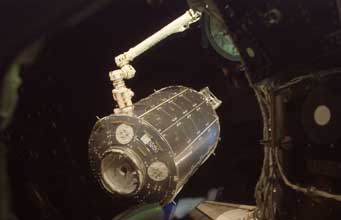When the Space Shuttle Atlantis lifted off on February 7th, it carried the European Space Agency's Columbus module for the International Space Station (ISS). Although the use of its pressurized compartment to house European astronauts has had the most publicity, the component also boasts some scientific instruments, including an astronomical experiment, dubbed Solar.

The European-built Columbus laboratory was attached to the International Space Station on February 11th. The exterior instrument platforms, which will carry three solar telescopes, are at the far end of the module in this photograph looking out an ISS window.
NASA
The Columbus module was connected to ISS on February 11th. During today's spacewalk, astronauts will install the instrument collection onto the platform at the end of the laboratory.
Solar carries three solar physics instruments. They cover the extreme-ultraviolet to mid-infrared region of the spectrum and will study the Sun's overall output, a critical parameter for climate-change studies. The instruments are installed on a rotating mount that compensates for the motion of ISS and keeps them pointed to 1° accuracy. While this wouldn't be enough for a high-resolution telescope, it's sufficient for a facility with wide-field instruments trying to monitor the whole Sun.
The Solar Variable and Irradiance Monitor (SOVIM) consists of 16 different detectors. Three of them incorporate the difficult technology of absolute radiometers, which directly measure the wattage of radiation collected, instead of setting their energy scale using workarounds like standard stars.
The other instruments face similar challenges. Calibration will also be tricky with the Solar Auto-Calibrating Extreme UV/UV Spectrophotometers (SOL-ACES), which will collect extreme-ultraviolet photons using grazing-incidence telescopes. The Solar Spectral Irradiance (SOLSPEC) instrument has flown in space several times on Spacelab missions lasting up to two weeks.
Solar's instruments will be controlled from a science mission center in Brussels, Belgium, working on concert with the main Columbus control center in Oberpfaffenhofen, Germany.
 0
0
Comments
You must be logged in to post a comment.